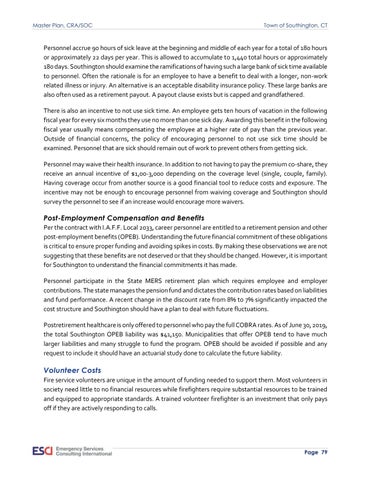Master Plan, CRA/SOC
Town of Southington, CT
Personnel accrue 90 hours of sick leave at the beginning and middle of each year for a total of 180 hours or approximately 22 days per year. This is allowed to accumulate to 1,440 total hours or approximately 180 days. Southington should examine the ramifications of having such a large bank of sick time available to personnel. Often the rationale is for an employee to have a benefit to deal with a longer, non-work related illness or injury. An alternative is an acceptable disability insurance policy. These large banks are also often used as a retirement payout. A payout clause exists but is capped and grandfathered. There is also an incentive to not use sick time. An employee gets ten hours of vacation in the following fiscal year for every six months they use no more than one sick day. Awarding this benefit in the following fiscal year usually means compensating the employee at a higher rate of pay than the previous year. Outside of financial concerns, the policy of encouraging personnel to not use sick time should be examined. Personnel that are sick should remain out of work to prevent others from getting sick. Personnel may waive their health insurance. In addition to not having to pay the premium co-share, they receive an annual incentive of $1,00-3,000 depending on the coverage level (single, couple, family). Having coverage occur from another source is a good financial tool to reduce costs and exposure. The incentive may not be enough to encourage personnel from waiving coverage and Southington should survey the personnel to see if an increase would encourage more waivers.
Post-Employment Compensation and Benefits Per the contract with I.A.F.F. Local 2033, career personnel are entitled to a retirement pension and other post-employment benefits (OPEB). Understanding the future financial commitment of these obligations is critical to ensure proper funding and avoiding spikes in costs. By making these observations we are not suggesting that these benefits are not deserved or that they should be changed. However, it is important for Southington to understand the financial commitments it has made. Personnel participate in the State MERS retirement plan which requires employee and employer contributions. The state manages the pension fund and dictates the contribution rates based on liabilities and fund performance. A recent change in the discount rate from 8% to 7% significantly impacted the cost structure and Southington should have a plan to deal with future fluctuations. Postretirement healthcare is only offered to personnel who pay the full COBRA rates. As of June 30, 2019, the total Southington OPEB liability was $41,150. Municipalities that offer OPEB tend to have much larger liabilities and many struggle to fund the program. OPEB should be avoided if possible and any request to include it should have an actuarial study done to calculate the future liability.
Volunteer Costs Fire service volunteers are unique in the amount of funding needed to support them. Most volunteers in society need little to no financial resources while firefighters require substantial resources to be trained and equipped to appropriate standards. A trained volunteer firefighter is an investment that only pays off if they are actively responding to calls.
Page 79












